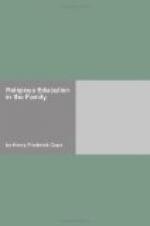CHAPTER II
THE PRESENT STATUS OF FAMILY LIFE
Sec. 1. CONTRASTED TYPES
In a beautiful village, in one of the farther western states, two men were discussing the possible future of the home and of family life. Sitting in the brilliant moonlight, looking through the leafy shades, watching the lights of a score of homes, each surrounded by lawn and shade trees, each with its group on the front porch, where vines trailed and flowers bloomed, listening to the hum of conversation and the strains of music in one home and another, it seemed, to at least one of these men, that this type of living could hardly pass away. The separate home, each family a complete social integer, each with its own circle of activities and interests, its own group, and its own table and fireside, seemed too fine and beautiful, too fair and helpful, to perish under economic pressure. Indeed, one felt that the village home furnished a setting for life and a soil for character development far higher and more efficient than could be afforded by any other domestic arrangement—that it approached the ideal.
But two weeks later two men sat in an upper room, in the second largest city in America, discussing again the future of the family. Instead of the quiet music of the village, the clang of street cars filled the ears, trains rushed by, children shouted from the paved highway, families were seated by open windows in crowded apartments, seeking cool air; the total impression was that of being placed in a pigeonhole in a huge, heated, filing-case, where each separate space was occupied by a family. One felt the pressure of heated, crowded kitchens, suffocating little dining-rooms; one knew that the babies lay crying in their beds at night, gasping their very lives away, and that the young folks were wandering off to amusement parks and moving-picture shows. Here was an entirely different picture. How long could family life persist under these conditions where privacy was almost gone and comfort almost unknown?
In the village separate home integers appear ideal; in the city they are possible only to the few. The many, at present, find them a crushing burden. Desirable as privacy is, it can be purchased at too high a price. It costs too much to maintain separate kitchens and dining-rooms under city conditions.
Sec. 2. COMMUNAL TENDENCIES
Present conditions spell waste, inefficiency, discomfort. The woman lives all day in stifling rooms, poorly lighted, with the nerve-racking life of neighbors pouring itself through walls and windows. The men come from crowded shops and the children from crowded schoolrooms to crowd themselves into these rooms, to snatch a meal, or to sleep. How can there be real family life? What joy can there be or what ideals created in daily discomfort and distress? Little wonder that such homes are sleeping-places only, that there is no sense of family intercourse and unity. Little wonder that restaurant life has succeeded family life.




